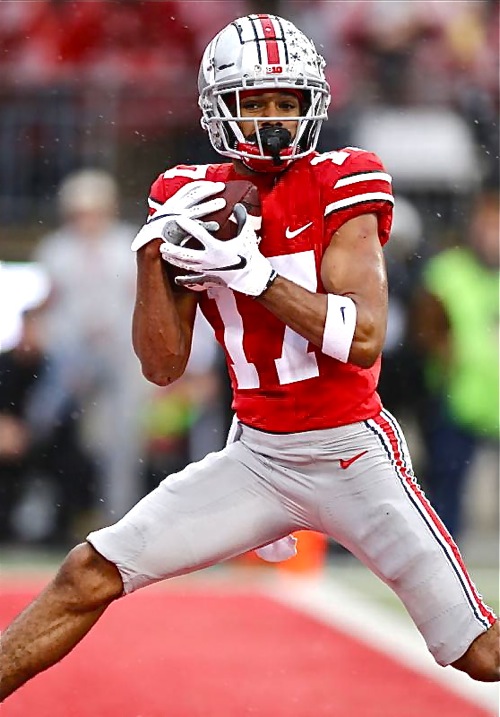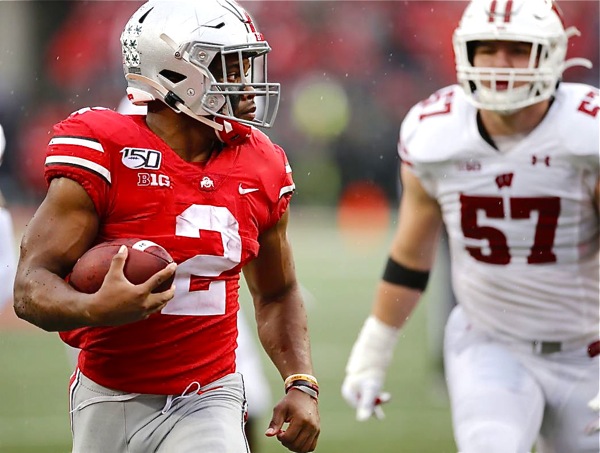Wisconsin kept it close for a while, but Ohio State scored on four straight possessions on way to blowout … Dobbins out-duels Taylor in battle of two top backs … Young ties program record with four sacks in dominant performance
 COLUMBUS — Since Ohio State had such an easy time while bashing its first seven opponents this year — racking up a gaudy 348-56 point differential — we haven’t had a chance to see whether it could manage the nerves and self-doubt that surface in a tight game where a loss can blow up a season.
COLUMBUS — Since Ohio State had such an easy time while bashing its first seven opponents this year — racking up a gaudy 348-56 point differential — we haven’t had a chance to see whether it could manage the nerves and self-doubt that surface in a tight game where a loss can blow up a season.
Now we know.
The third-ranked Buckeyes (8-0) committed the first egregious mistake of the day against No. 13 Wisconsin (6-2), getting a punt blocked deep in their territory while clinging to a 10-0 lead early in the second half.
On third-and-6 at the 26, Jack Coan hit A.J. Taylor in traffic for a TD, making it 10-7.
Uh-oh.
Wisconsin, which had five sacks to that point while playing relentless defense, put Ohio State in a position where it had to play with pressure for the first time.
The response? A tidy eight-play drive that covered 75 yards. It included a 28-yard dash by J.K. Dobbins and a 10-yard scoring run by quarterback Justin Fields.
“Our motto as an offense is no one can stop us except us,” Fields said. “We kept our heads straight, went on the field and played our game. As a team, we react well to adversity.”
That was the start of the Buckeyes’ usual offensive onslaught — a little later than we’ve come to expect, but as masterful as ever.
They scored on four straight possessions to end the suspense — brushing off a steady rain and sloppy conditions — on the way to a 38-7 victory that clearly stamped them as the most complete team in college football.

“I think we could have put up 50,” said QB Justin Fields. Chris Olave scored six of them with this second quarter touchdown.
“I think we could’ve put up 50 points if the weather was better,” said Fields, who was held back a bit by a conservative game plan but finished 12 of 22 for 167 yards and two touchdowns, giving him 24 TD passes with one interception.
Yes, the Badgers were wounded after an inexplicable loss at Illinois last week, but they still had the No. 1 defense in the country in every major stat. They led Michigan, 35-0, before giving up a point. They beat Michigan State, 38-0.
The Buckeyes were ranked No. 2 defensively, and they certainly lived up to that billing.
Chase Young was the Tasmanian Devil once more, getting a school-record-tying four sacks, forcing two fumbles and picking up another tackle for loss. A pure defensive player probably will never win the Heisman, but Young at least deserves a seat at the ceremony.
The Buckeyes amassed 431 yards while giving up just 191. And in the individual showdown between two of the nation’s premier backs, the contest wasn’t even close.
Running behind a top-notch line, Dobbins, the quick, compact and indestructible junior, scooted for 163 yards and two TDs on 20 carries. He also had three catches for 58 yards.
Jonathan Taylor, the Badgers’ ballyhooed junior, finished with 52 yards on 20 lugs and had one catch for five yards. He never reached the end zone.
“J.K. ran with an edge all day,” Ohio State coach Ryan Day said. “I think he’s the best running back in the country. When you look at the other side of the ball and what Chase did, his impact was felt throughout the game.
“He’s probably the most dominant player in all of college football right now. His impact in a game like this showed his versatility. It wasn’t just a passing game where he could go after the quarterback. He had to play tough and gritty inside. The whole defensive line controlled the game.”
The Buckeyes went with four linebackers much of the time, starting injury-plagued fifth-year senior Justin Hilliard with Tuf Borland, Pete Werner and Malik Harrison.
I was skeptical of the move at first. Maybe you do that because of the Badgers’ Rhino sets with extra offensive linemen on the field, yet that meant defensive back Shaun Wade, a breakout star this year, was left too often on the sidelines.
But it worked.

Bowlerstore.com, in Versailles, Ohio, is a proud sponsor of the Buckeyes on Press Pros Magazine.com.
The Buckeyes were content to see if Coan was capable of beating them through the air. He went 10 of 17 for a measly 108 yards. Yep, that’s why it’s better to keep me behind a laptop rather than leading a strategy session.
Fields is so valuable because of his ability to keep plays alive with his feet, but he and his unit had a ragged start.
On the first possession, one shotgun snap by center Josh Myers caught everyone by surprise, leading to a big loss, and two Dobbins runs went nowhere.
The Buckeyes gained a pair of first downs on their second series, and then Fields couldn’t handle a hard snap on third-and-5. He was stuffed.
And when the offense trotted out the next time, the sophomore QB was smothered for another sack (if he has a weakness, it’s his propensity to hold the ball too long).
Three series, three punts.

Chase Young was his usual destructive self, tying a school record with four sacks.
But the Buckeyes finally showed some life when they motored into field-goal range, and Blake Haubeil, coming off his 55-yarder against Northwestern, put a 49-yard boot through the tent poles for a 3-0 lead at 6:52 of the second quarter.
The Buckeyes, who allowed just four first downs and 72 total yards in the first half, gave the offense another possession just before halftime, and it wasn’t wasted.
Fields had a 21-yard scramble for a huge hit — yep, son, those yards are there more often than you may think — and, on third-and-13, he threw an arrow to Chris Olave for a 27-yard score with 43 seconds to go.
That’s the difference between these Buckeyes and previous Ohio State teams, at least the ones I’ve covered over the years.
If the offense needs time to get going, the defense has its back.
SO LONG, COMMISH: Let’s take a minute to laud Big Ten commissioner Jim Delany (yes, we’re being facetious), who is retiring in 2020 after 30 years. To his credit (seriously), he brought Penn State and Nebraska to the conference, which were big gets, while reaching too much for Maryland and Rutgers. And he had the foresight to know the Big Ten Network could become a cash cow.
But after reading this week how much the Buckeyes’ Friday night game at Northwestern hurt Ohio high school football revenues — and how much Friday night conference games in general will keep stinging — that misstep is also part of his legacy. Delany should have known better.
As noted in one piece I saw, high school football needs the money much more than the Big Ten does.
There is another short-sighted element to the league agreeing to that massive, $2-billion TV contract. They’re now playing nine league games, giving their top teams a more strenuous path to the playoffs.
The Big 12 and PAC-12 also are playing nine, but the SEC and ACC play only eight, meaning their teams can schedule an automatic win while the other leagues are putting their contenders at risk.
That would be fine if the committee awarded tougher scheduling, but it doesn’t.

Veteran writer Doug Harris reports Buckeyes football exclusively for Press Pros Magazine.
Playing nine games also guarantees half of your teams will be tagged with another loss, which is a factor in the polls. That becomes important when resumes are compared at the end of the season.
It’s no wonder the SEC and ACC are the only leagues that have sent teams to the playoffs every year.
Urban Meyer has been banging the drum about this lately (he’s more free to speak than he was as a coach, I guess). He believes all teams should play an equal number of conference games, even if that means the Big Ten goes back to eight.
Delany probably would agree.
Just don’t expect him to give that money back.

The McKinley Funeral Home of Lucasville, Ohio, proudly supports Ohio State Buckeye baseball on Press Pros.

J.K. Dobbins finished the win over Wisconsin with 163 rushing yards on 20 carries, with two touchdowns. (Press Pros Photos Courtesy of OSU Sports)


